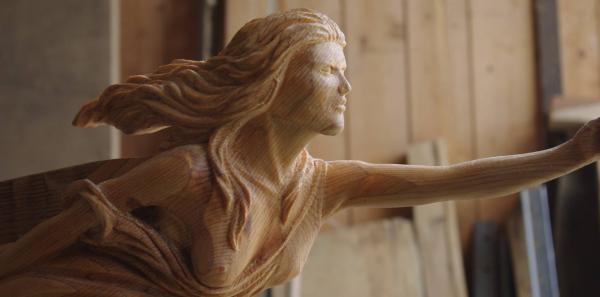 In a few days, the composite clipper ship Cutty Sark will be graced with a new carved wooden figurehead carved by one of the last master carvers, Andy Peters. The figurehead, like its two predecessors, represents the witch Nannie Dee, from Robert Burn’s poem, Tam o’ Shanter. She is scantily clad and holds a long tuft of a horse’s tail in her outstretched hand. The figurehead itself tells the story of why the grand old ship is named Cutty Sark.
In a few days, the composite clipper ship Cutty Sark will be graced with a new carved wooden figurehead carved by one of the last master carvers, Andy Peters. The figurehead, like its two predecessors, represents the witch Nannie Dee, from Robert Burn’s poem, Tam o’ Shanter. She is scantily clad and holds a long tuft of a horse’s tail in her outstretched hand. The figurehead itself tells the story of why the grand old ship is named Cutty Sark.
In Burn’s poem, Tam o’Shanter stays too long drinking at the pub and on his way home witnesses strange goings-on in a churchyard. In the Alloawy Kirk, he sees witches and warlocks and even the devil himself dancing and cavorting in wild abandon. Tam is particularly taken by a young witch, Nannie Dee, “ae winsome wench and wawlie,” dancing nearly naked in a small nightgown, called a cutty sark, that she has clearly outgrown. In a fit of passion Tam calls out, “Weel done, Cutty-sark!”
The witches and devils take off after Tam, who jumps of his horse and rides for the nearby bridge across a local stream, because according to folklore, witches cannot cross running water. He nearly makes good his escape but Nannie Dee manages to grab Tam’s horse’s tail, which comes off. Tam crosses the bridge and she is left scowling, holding the tuft of horse’s hair.
The first figurehead that adorned the bow was delivered with the ship in 1869 and is believed to have been based on a sketch made by Hercules Linton, who designed and built the clipper ship. Almost a century later, the original figurehead was rather worse for the wear, missing its head and arm either due to heavy weather or perhaps a collision.

Second Figurehead Carved in 1957
A second Nannie figurehead was carved in 1957 but has now also succumbed to rot. Andy Peters was commissioned to carve a new Nannie Dee. To do so, he relied, in part, on the original sketch by Hercules Linton. The new Nannie has less of a scowl on her face and her scanty attire is more a chemise than the Grecian style robe of the previous carving.
Tam’s exuberant cry “Weel done, Cutty-sark!” was popular in 19th-century Britain and became a synonym for “good job,” capturing the optimism of the clipper ship era. Nevertheless, there is an abiding irony that the namesake figurehead of the ship that crossed so many oceans is of a witch that could not so much as cross a moving stream.
Here is a short video about how Andy Peters carved the new figurehead.
The Art Of Ship’s Figurehead Carving
Thanks to Dick Kooyman for contributing to this post.

What a great point about the irony. I never thought about it like that before!